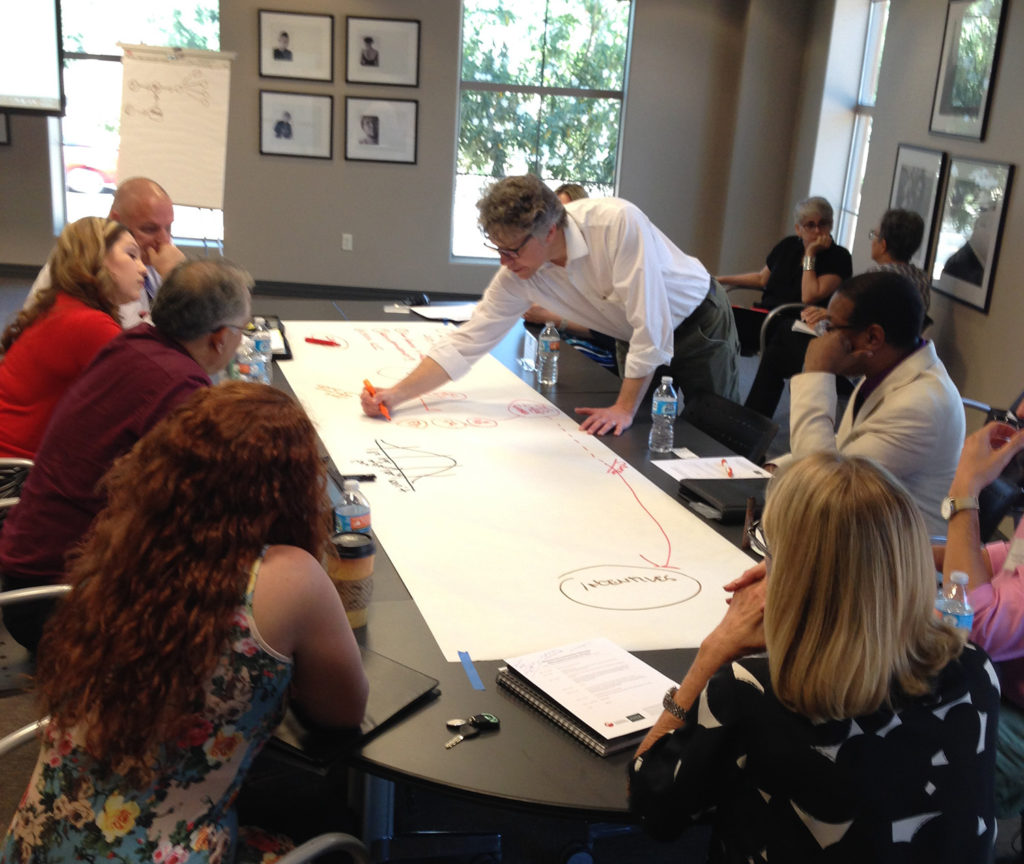Community leaders in Arizona’s Maricopa County are facing a compounding public health challenge: how to provide relief to the summer’s anticipated heat waves while social distancing to reduce the spread of COVID-19.
Temperatures in Maricopa County, which includes the City of Phoenix, have already hit 100 degrees, and the Climate Prediction Center is anticipating a hotter than normal summer. Many of the county’s network of public hydration stations and heat-relief refuges, where people would normally gather during the hottest parts of the day, are no longer viable options due to the pandemic.
As these two crises converge, we are seeing something we have known for a while play out in real-time: the critical role social cohesion plays in a community’s ability to adapt to crisis. ISC has been working with the Maricopa County Department of Public Health since November 2019 to reduce heat related deaths in the region, and for the past four years has been working to increase “social cohesion,” building trust, empathy and a shared sense of identity among community members and leaders.

Social vs. Physical Infrastructure
When talking about resilience for cities, we often focus on designing and building physical infrastructure: design a transit-oriented development, design bioswales for stormwater management, build a solar microgrid, build passive housing. These things are all important and impactful, but we often focus on physical infrastructure at the expense of social infrastructure.
Social infrastructure is often referred to in terms of social capital and social cohesion. Social capital refers to the existence of interpersonal connections, bonds, and shared interests. It is a neutral term—these connections can be good or bad.
Social cohesion refers to positive interpersonal connections. It is measured through trust, empathy, and a shared sense of identity, and characterized by community members who are willing to make sacrifices for one another in service of a common goal. Any given community, while technically connected, can have varying levels of social cohesion, be it your family, your neighborhood, or your knitting club.
In the U.S., social cohesion is low and has been trending down. A Pew Research Center report released last year found that 58 percent of U.S. adults believe that people will try to take advantage of you if they get the chance, and 62 percent of U.S. adults believe that people are just looking out for themselves. Further, 67 percent of U.S. adults have little to no confidence in the federal government and 63 percent have little to no confidence in elected officials.
In any conversation about rebuilding post-COVID-19, we should be thinking about how we restore trust between individuals, communities, institutions, and government, recognizing that specifically in the case of our government, trust is earned.

The work that ISC has done in Maricopa County offers a pathway forward for how we can build social cohesion. Four years ago, ISC partnered with the Virginia Piper Trust Foundation to create the Advancing Community Resilience Partnership (ACRP). As part of our initial community resilience assessment, we identified the lack of social cohesion as a central challenge for the region.
We found that many [of those interviewed] traced this lack of social capital to several factors:
- the large proportion of the population who “aren’t from here”
- prevailing development patterns that separate neighbors
- lack of racial integration and inclusion
- prevailing governing ethos of limited government
This lack of social cohesion contributed to a fragmented human services sector. During our time as part of the ACRP, we facilitated the formation and strengthening of a number of regional collaboratives with the aim of increasing coordination of services. We knew from our assessment that for these groups to be effective, it was critically important to build social cohesion.
However, you cannot just “build” social cohesion like you can build a dam or a wind farm. People are complex, and there is never a guarantee that any group of people will learn to trust or empathize with each other. In order to intentionally build social cohesion, we worked to ensure that our processes created the spaces and structures that could foster positive social growth. Here are a few examples of what this work looked like in Maricopa County:
- Open Lunch. Social cohesion began with something as basic as an unstructured lunch with the Eyes on Learning Vision Coalition. Often when scheduling a day-long workshop, it is tempting to have a working lunch. After all, you only have everyone in the room for so long—“gotta squeeze in as much as you can.” But we have seen the value of an unstructured lunch in giving people the opportunity to get to know each other and to form positive relationships. Early on, coalition meetings were lightly attended and the lunches were whisper quiet. But at our last workshop, the room was packed and the lunch chatter was deafening.
- One-on-one Interviews. In working with Read On Arizona to build a partnership agreement between three Read On communities, we recognized that there were a number of factors contributing to fragmentation: turnover, different sectors, and busy people with full plates. So as part of the process for building the partnership, we held individual interviews to ensure that participants’ concerns were heard and questions were answered. Then we used those interviews to build the agenda for a partnership agreement meeting so that people felt comfortable and well-informed.
- Systems Mapping. When we partnered to form the Utility Assistance Network, we created a systems map for all utility assistance processes in Maricopa County. This helped the partner organizations to understand each others’ roles and strengths. From there, they could better visualize the user’s experience and work together to streamline utility assistance services for low-income residents.
In each of these cases, our facilitation processes led to results: collective strategic priorities, signed partnership agreements, and restructured systems. So, as we face the heat (literally and figuratively) of the next several months, we know that ISC must continue to intentionally build social cohesion across our programs and collaboratives.
Social Cohesion and the Response to COVID-19
This much is also clear: the same social cohesion that enables communities to adapt to climate change will allow us to respond to a public health pandemic. Before we dive into solutions that are “shovel-ready,” which can be especially tempting after a crisis, let’s think about the kinds of investments that will lead to lasting, systems-level change. Complex strategies, community education programs, and recovery task forces can be effective—but not if we skip lunch.
Our collective lunch table looks different these days. We are still working on a plan for how to help vulnerable Arizonans get out of the heat while avoiding the coronavirus. But the coalitions we helped build in the county, and the strong underlying ties that made them successful, provide a solid infrastructure from which to start. We are excited to see the solutions that arise from the community when they are given the space, time, and opportunity to truly connect and foster trust.
Daniel Dickerman is a Program Officer for ISC’s US Program, where he supports ISC’s work to build community resilience at the regional level.
Since 1991, ISC has led more than 115 transformative community-driven sustainability projects in 30 countries including the United States, China, India, and Bangladesh. ISC helps unleash the existing power of local people and institutions to address immediate social, economic, and environmental challenges and opportunities – all while building those on-the-ground solutions into national and international best practices and policy. At the heart of the organization’s approach is results-focused, authentic, and pragmatic engagement with all stakeholders, which unearths locally-driven and equitable solutions to the biggest challenge we face – global climate change. Learn more at sustain.org
